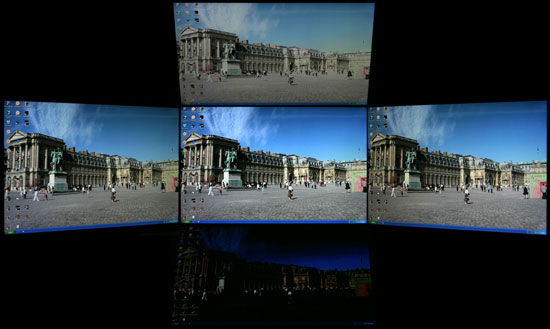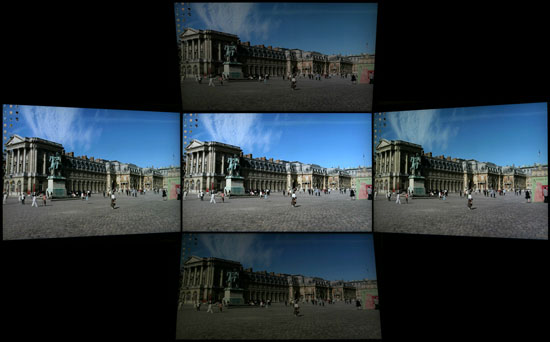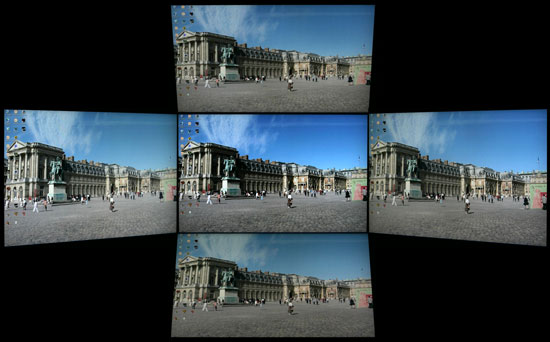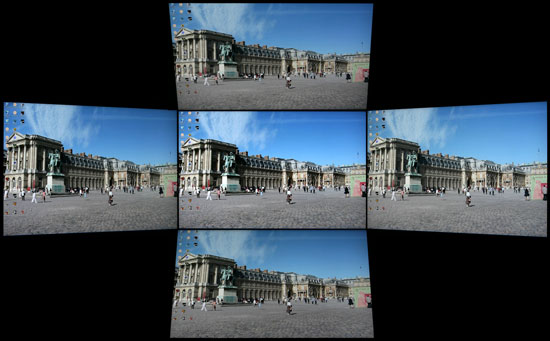Acer AL2216W: a worthwhile compromise?
by Jarred Walton on March 10, 2007 3:00 PM EST- Posted in
- Displays
Viewing Angles
We mentioned earlier that we would revisit some of the aspects of the other displays, and viewing angles are one of those areas that several readers wanted us to explore further. We used our camera to take shots from head-on as well as from the left and right sides at ~30° angles, showing how brightness and contrast ratios can drop dramatically in off-angle viewing. We also took pictures from above and below at ~30° angles. Here's the quick comparison of all the LCDs we have reviewed so far.
If it's not patently obvious from the above images (which we sorted in order of increasing quality), the viewing angle of the Acer's TN panel is much worse than any of the other tested displays. The Dell 3007WFP is in fourth place, which considering the use of an IPS panel was somewhat unexpected as IPS panels are known for providing a wide viewing angle. The sheer size of the panel may be partly to blame; getting accurate photos from the top and bottom angles was difficult, and subjectively we actually felt the 3007WFP was slightly better than the 2405FPW. The Dell 2405FPW places next, and considering that display is two years old it still makes a reasonable showing. The Gateway FPD2485W and Dell 2407WFP are basically tied for first, and while the placing was not a foregone conclusion their relative performance isn't at all surprising considering the two panels appear to be virtually identical.
We wouldn't be too concerned about viewing angles personally, as outside of the Acer display, all of the LCDs are generally acceptable for use within a 60° viewing arc, both horizontally and vertically. The Acer panel suffers mostly in the vertical viewing angle, so it can still be used within a 60° arc provided your eyes are in roughly the same vertical plane. Beyond a 30° angle, the IPS panel on the 3007WFP does seem to have a slight edge; however, we don't generally think most people use their computers staring at the screen from an oblique angle.
Anyone who is seriously concerned about accurate colors is going to want to view pretty much any display from a direct front angle, and that tends to be the most comfortable position as well. That's one of the reasons we don't really worry too much about viewing angles. However, some people might work in environments where off-angle viewing is more important, so it's not entirely meaningless.
Unfortunately, the manufacturer viewing angles tend to be exaggerated to the point of being useless, as the standard requirement is that the perceived image only needs to maintain a 10:1 contrast ratio. Even the extremely dark lower image on the Acer display above meets that requirement, but we can't imagine anyone would actually be able to use a display properly that way. When you have marketing material hyping 700:1 and even 1000:1 contrast ratios, it's ludicrous to even pretend that a 10:1 ratio is acceptable. 100:1 is good enough in a pinch, and maybe even a bit lower, but a 10:1 ratio is not at all practical.
We mentioned earlier that we would revisit some of the aspects of the other displays, and viewing angles are one of those areas that several readers wanted us to explore further. We used our camera to take shots from head-on as well as from the left and right sides at ~30° angles, showing how brightness and contrast ratios can drop dramatically in off-angle viewing. We also took pictures from above and below at ~30° angles. Here's the quick comparison of all the LCDs we have reviewed so far.
 Acer AL2216W |
 Dell 3007WFP |
 Dell 2405FPW |
 Dell 2407WFP |
 Gateway FPD2485W |
If it's not patently obvious from the above images (which we sorted in order of increasing quality), the viewing angle of the Acer's TN panel is much worse than any of the other tested displays. The Dell 3007WFP is in fourth place, which considering the use of an IPS panel was somewhat unexpected as IPS panels are known for providing a wide viewing angle. The sheer size of the panel may be partly to blame; getting accurate photos from the top and bottom angles was difficult, and subjectively we actually felt the 3007WFP was slightly better than the 2405FPW. The Dell 2405FPW places next, and considering that display is two years old it still makes a reasonable showing. The Gateway FPD2485W and Dell 2407WFP are basically tied for first, and while the placing was not a foregone conclusion their relative performance isn't at all surprising considering the two panels appear to be virtually identical.
We wouldn't be too concerned about viewing angles personally, as outside of the Acer display, all of the LCDs are generally acceptable for use within a 60° viewing arc, both horizontally and vertically. The Acer panel suffers mostly in the vertical viewing angle, so it can still be used within a 60° arc provided your eyes are in roughly the same vertical plane. Beyond a 30° angle, the IPS panel on the 3007WFP does seem to have a slight edge; however, we don't generally think most people use their computers staring at the screen from an oblique angle.
Anyone who is seriously concerned about accurate colors is going to want to view pretty much any display from a direct front angle, and that tends to be the most comfortable position as well. That's one of the reasons we don't really worry too much about viewing angles. However, some people might work in environments where off-angle viewing is more important, so it's not entirely meaningless.
Unfortunately, the manufacturer viewing angles tend to be exaggerated to the point of being useless, as the standard requirement is that the perceived image only needs to maintain a 10:1 contrast ratio. Even the extremely dark lower image on the Acer display above meets that requirement, but we can't imagine anyone would actually be able to use a display properly that way. When you have marketing material hyping 700:1 and even 1000:1 contrast ratios, it's ludicrous to even pretend that a 10:1 ratio is acceptable. 100:1 is good enough in a pinch, and maybe even a bit lower, but a 10:1 ratio is not at all practical.










32 Comments
View All Comments
kmmatney - Saturday, March 10, 2007 - link
I have the display and am happy with it. While I could easily nitpick away at various details, it's a great LCD at the $300 price point. However if I was buying a 22" TN display now, I'd go for the Dell 22" model. It has a much nicer stand, and looks better overall.rqle - Saturday, March 10, 2007 - link
Excellent setup on the viewing angle!